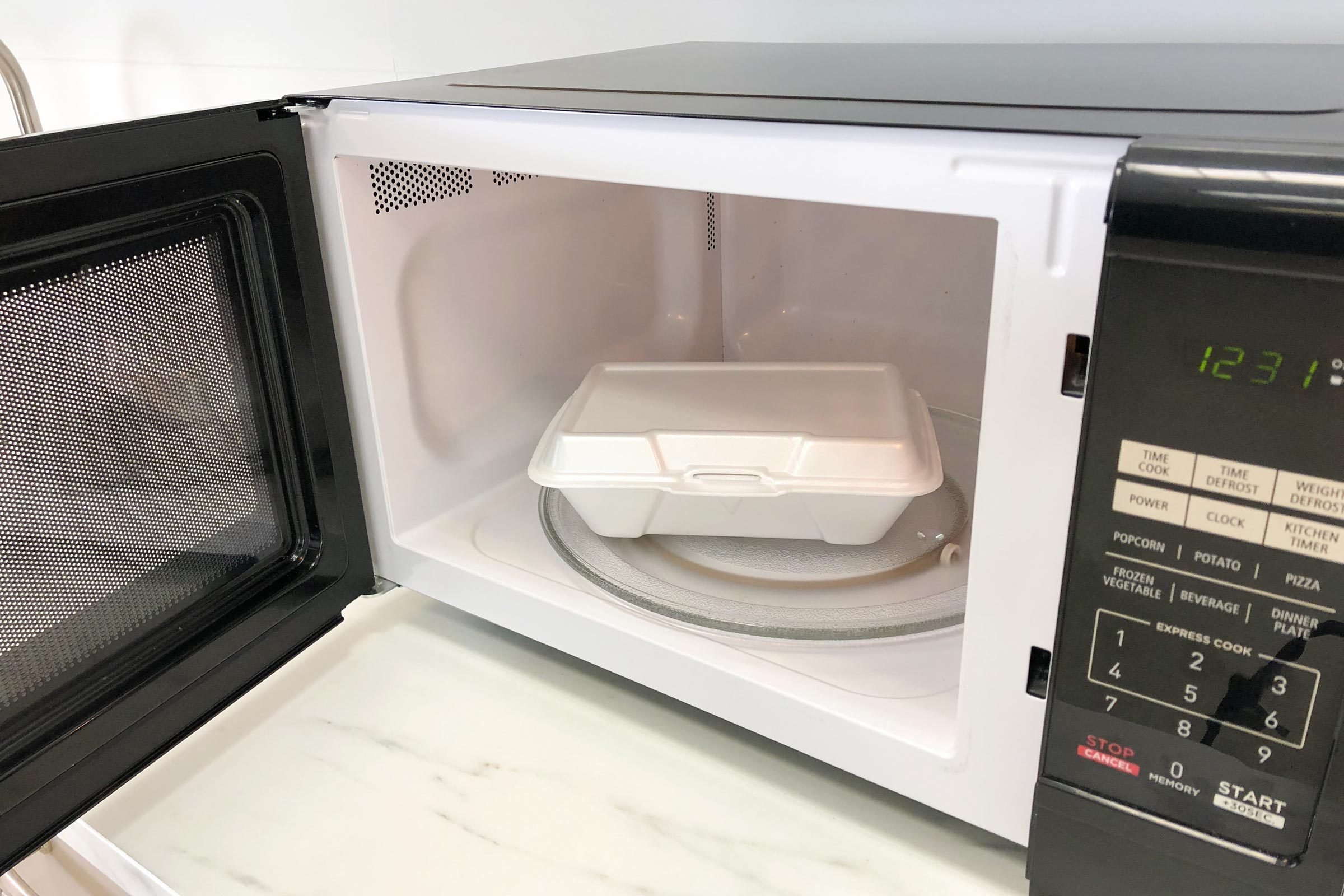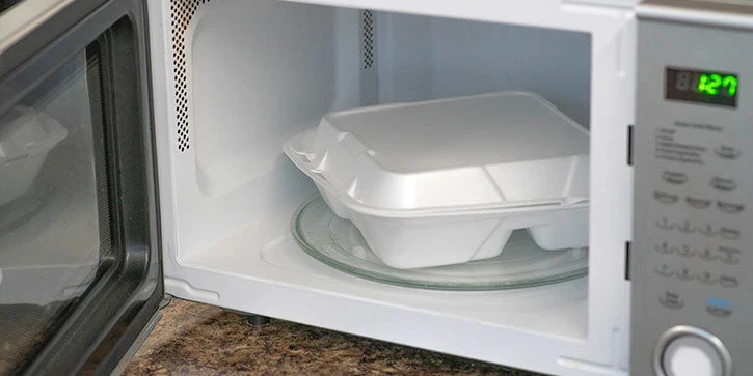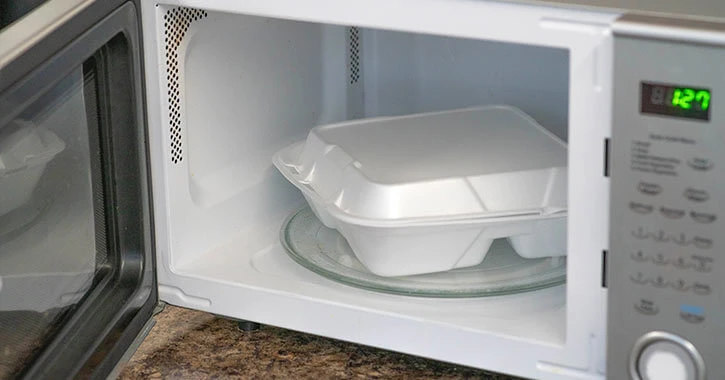No, you should not put Styrofoam in the microwave. It can melt or release harmful chemicals.
Table of Contents
ToggleMicrowaving food has become a common practice for many of us. It’s quick and easy. But not all containers are microwave-safe. Styrofoam, for example, poses risks when heated. Understanding these risks can help keep you safe and prevent accidents. In this post, we’ll explore why Styrofoam is not suitable for the microwave and what alternatives you can use.
Stay with us to learn how to use your microwave safely and effectively.
Microwave Safety
Putting Styrofoam in the microwave can be unsafe. It may release harmful chemicals when heated. Always check if the container is microwave-safe.
Microwaves have become an essential kitchen appliance. They offer convenience and speed in cooking and reheating food. But safety is a major concern. Understanding which materials are safe for microwaving is crucial.How Microwaves Work
Microwaves use electromagnetic waves to heat food. These waves cause water molecules in the food to vibrate, producing heat. This process cooks food quickly. But not all materials can withstand these waves.Materials Safe For Microwaving
Some materials are safe for use in the microwave. Glass, ceramic, and certain plastics are microwave safe. Look for labels that confirm microwave safety. Avoid using metal, as it can cause sparks. Not all plastics are safe, so double-check before use. “`Styrofoam In The Microwave
Putting Styrofoam in the microwave can be dangerous. It may melt, release harmful chemicals, and cause health risks. Always check for microwave-safe labels before use.
Styrofoam is a common material used for food containers. Many wonder if it is safe to microwave. This question is important for both safety and convenience. Let’s explore the risks and common misconceptions.Risks Of Microwaving Styrofoam
Microwaving Styrofoam can pose health risks. The heat can cause chemicals to leach into food. These chemicals may be harmful if ingested. Styrofoam can also melt when exposed to high heat. This can create a mess in your microwave. Melting Styrofoam can release toxic fumes. These fumes are not safe to breathe. Some Styrofoam containers are labeled “microwave-safe.” But this does not mean they are completely safe. It means they are less likely to melt or leach chemicals. Always check the label before microwaving.Common Misconceptions
Many believe all Styrofoam is microwave-safe. This is not true. Only specific types are designed for microwave use. Another misconception is that short microwaving times are safe. Even brief heating can release harmful chemicals. Some think using a microwave-safe Styrofoam container eliminates all risks. But even these containers can pose dangers. Always use caution and consider alternatives like glass or ceramic. Understanding these risks and misconceptions helps you make safer choices. Choose materials wisely to protect your health. “`Health Concerns
Many people wonder if they can put styrofoam in the microwave. One major concern is the potential health risks. This section will explore the health concerns related to microwaving styrofoam.
Chemical Leaching
Microwaving styrofoam can cause chemicals to leach into your food. Styrofoam contains substances like styrene and benzene. These chemicals can be harmful when heated.
- Styrene can break down when heated.
- It can mix with your food or drink.
- These chemicals are not safe for consumption.
It is vital to use microwave-safe containers to avoid chemical contamination.
Potential Health Effects
Exposure to the chemicals from styrofoam can have several health effects. These can range from mild to severe.
- Short-term effects: Headaches, dizziness, and nausea.
- Long-term effects: Increased risk of cancer and liver damage.
Children and pregnant women are more vulnerable to these risks. It’s better to stay on the safe side and avoid microwaving styrofoam.

Credit: www.tasteofhome.com
Environmental Impact
Microwaving Styrofoam might seem convenient, but it poses significant environmental risks. Styrofoam, or polystyrene, is a common packaging material. Its disposal and impact on the environment raise many concerns. Let’s explore these issues further.
Styrofoam Disposal Issues
Styrofoam is not biodegradable. It can take hundreds of years to break down. This leads to massive waste accumulation in landfills. Animals mistake Styrofoam for food. This can cause health problems or death. Burning Styrofoam releases harmful chemicals. These chemicals contribute to air pollution and health hazards.
Sustainable Alternatives
Consider using reusable containers. Glass or ceramic dishes are microwave-safe and eco-friendly. Look for biodegradable packaging. Materials like paper or plant-based plastics decompose faster. Support companies that use sustainable packaging. Making these small changes helps reduce environmental impact. Every little effort counts.
Alternatives To Styrofoam
Styrofoam is common in many kitchens. It’s cheap and convenient. But it’s not safe for microwaving. Fortunately, there are many safe and eco-friendly alternatives. These options protect your health and the environment.
Microwave-safe Containers
Choosing the right container is key. Below are some microwave-safe options:
- Glass Containers: They are durable and safe for microwaving. Plus, they don’t absorb odors.
- Ceramic Dishes: These are also safe and can be stylish. Make sure they are labeled microwave-safe.
- Pyrex: This brand offers heat-resistant glassware. It’s reliable for both cooking and storing food.
- Microwave-Safe Plastic: Look for labels on the bottom. BPA-free plastic containers are a safer choice.
These containers are not only safe but also versatile. You can use them for reheating, cooking, and storing food.
Eco-friendly Options
For those who care about the environment, eco-friendly options are ideal. Consider the following:
- Bamboo Containers: These are biodegradable and safe for microwaving. They are also stylish.
- Recycled Paper Containers: These are compostable and microwave-safe. They are often used for takeout.
- Stainless Steel: While not microwave-safe, stainless steel is a great option for storage. It’s durable and eco-friendly.
- Silicone Containers: These are flexible, durable, and microwave-safe. Silicone is also reusable.
Switching to eco-friendly containers helps reduce waste. It also ensures your food is safe from harmful chemicals.
| Material | Microwave-Safe | Eco-Friendly |
|---|---|---|
| Glass | Yes | No |
| Ceramic | Yes | No |
| Pyrex | Yes | No |
| Microwave-Safe Plastic | Yes | No |
| Bamboo | Yes | Yes |
| Recycled Paper | Yes | Yes |
| Stainless Steel | No | Yes |
| Silicone | Yes | Yes |

Credit: www.instagram.com
Tips For Safe Microwaving
Microwaving food is quick and easy. But, it can be dangerous if done incorrectly. Not all containers are microwave-safe. Using the wrong ones can cause harm. Here are some tips for safe microwaving.
Choosing The Right Containers
Always use microwave-safe containers. Look for labels that say “microwave-safe.” Glass and ceramic are good choices. Avoid metal. Metal can cause sparks. Avoid using Styrofoam unless it is labeled as microwave-safe. Regular Styrofoam can melt and leach chemicals into your food.
| Container Type | Microwave-Safe |
|---|---|
| Glass | Yes |
| Ceramic | Yes |
| Plastic (labeled microwave-safe) | Yes |
| Metal | No |
| Regular Styrofoam | No |
Proper Microwaving Techniques
Follow these steps for safe microwaving:
- Use a microwave-safe cover. This prevents splatters and helps food cook evenly.
- Stir and rotate food halfway through cooking. This ensures even heating.
- Allow standing time after microwaving. Food continues to cook after the microwave stops.
- Avoid overheating. Overheating can cause burns and damage containers.
Microwaves heat unevenly. Be cautious with foods that have different densities. For example, a potato might be hot on the outside but cold inside. Always test the temperature before eating.
By following these tips, you can enjoy safe and effective microwaving. Remember, safety first!

Credit: www.mrappliance.ca
Frequently Asked Questions
Is It Safe To Microwave Styrofoam?
No, it’s not safe to microwave Styrofoam. It can release harmful chemicals. Always check the label for microwave safety.
What Happens If You Microwave Styrofoam?
Microwaving Styrofoam can cause it to melt and release toxic chemicals. It’s unsafe and not recommended.
Can You Reheat Food In Styrofoam Containers?
It’s best to avoid reheating food in Styrofoam containers. They can melt and release harmful chemicals into your food.
Are All Styrofoam Products Microwave-safe?
Not all Styrofoam products are microwave-safe. Always check the label for microwave safety instructions before use.
Conclusion
Microwaving Styrofoam can be risky. Some types release harmful chemicals when heated. Always check the label for microwave safety. Use glass or microwave-safe containers instead. Your health matters. Avoid potential hazards. Safe practices keep your food and microwave secure. Stay informed and make smart choices.
Your kitchen routine will be better for it.
{ “@context”: “https://schema.org”, “@type”: “FAQPage”, “mainEntity”: [ { “@type”: “Question”, “name”: “Is it safe to microwave Styrofoam?”, “acceptedAnswer”: { “@type”: “Answer”, “text”: “No, it’s not safe to microwave Styrofoam. It can release harmful chemicals. Always check the label for microwave safety.” } } , { “@type”: “Question”, “name”: “What happens if you microwave Styrofoam?”, “acceptedAnswer”: { “@type”: “Answer”, “text”: “Microwaving Styrofoam can cause it to melt and release toxic chemicals. It’s unsafe and not recommended.” } } , { “@type”: “Question”, “name”: “Can you reheat food in Styrofoam containers?”, “acceptedAnswer”: { “@type”: “Answer”, “text”: “It’s best to avoid reheating food in Styrofoam containers. They can melt and release harmful chemicals into your food.” } } , { “@type”: “Question”, “name”: “Are all Styrofoam products microwave-safe?”, “acceptedAnswer”: { “@type”: “Answer”, “text”: “Not all Styrofoam products are microwave-safe. Always check the label for microwave safety instructions before use.” } } ] }

